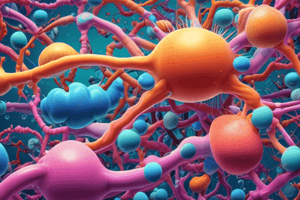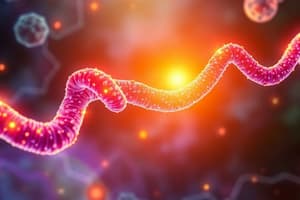Podcast
Questions and Answers
What is the function of the signal recognition particle (SRP)?
What is the function of the signal recognition particle (SRP)?
- To identify asparagine residues for N-linked glycosylation
- To associate with the SRP receptor on the ER membrane (correct)
- To facilitate the formation of disulphide bonds in the ER lumen
- To cleave the N-terminal signal sequence
What is the purpose of the translocon in the ER membrane?
What is the purpose of the translocon in the ER membrane?
- To cleave the N-terminal signal sequence
- To check the signal sequence of the peptide and insert it in the appropriate orientation (correct)
- To identify asparagine residues for N-linked glycosylation
- To facilitate the formation of disulphide bonds
What is the role of oligosaccharyl transferase in the ER?
What is the role of oligosaccharyl transferase in the ER?
- To facilitate the formation of disulphide bonds
- To cleave the N-terminal signal sequence
- To identify asparagine residues for N-linked glycosylation (correct)
- To pull the growing peptide into the ER lumen
What happens to the SRP after the SRP-nascent peptide chain associates with the SRP receptor?
What happens to the SRP after the SRP-nascent peptide chain associates with the SRP receptor?
What is the role of chaperone proteins in the ER?
What is the role of chaperone proteins in the ER?
What is the ultimate fate of the membrane-spanning domains in the ER?
What is the ultimate fate of the membrane-spanning domains in the ER?
What percentage of ER proteins are marked for degradation?
What percentage of ER proteins are marked for degradation?
What is the purpose of ubiquitin ligase in the ERAD pathway?
What is the purpose of ubiquitin ligase in the ERAD pathway?
What is the result of the delta 508F mutation on CFTR?
What is the result of the delta 508F mutation on CFTR?
What is the strategy used by human cytomegalovirus (CMV) to remain hidden?
What is the strategy used by human cytomegalovirus (CMV) to remain hidden?
What is the genetic defect associated with Parkinson's disease?
What is the genetic defect associated with Parkinson's disease?
Flashcards are hidden until you start studying
Study Notes
Signal Sequence and SRP
- A signal sequence is internally located in terminal or integral membrane proteins.
- The sequence is recognized by the signal recognition particle (SRP), a large protein-RNA complex, as soon as it is translated.
SRP-Nascent Peptide Chain Association
- Translation arrests, allowing time for the SRP-nascent peptide chain to associate with the SRP receptor on the ER membrane.
- The SRP receptor associates with a translocon (ER membrane channel).
Signal Sequence Orientation and Insertion
- The translocon checks the signal sequence of the peptide and inserts the nascent peptide in the appropriate orientation.
- The orientation of the peptide cannot be altered later.
SRP Release and Protein Synthesis
- The SRP is released to be re-used, and protein synthesis resumes, threading the growing protein through the translocon.
Translocon and Hydrophobic Residues
- The translocon continues to survey the growing protein, looking for stretches of hydrophobic residues that will form membrane-spanning domains.
- These hydrophobic residues are retained in the translocon until all TMDs are fully assembled, then they pass into the ER membrane.
Protein Modifications in ER Lumen
- The growing peptide is scrutinized by further enzymes in the ER lumen.
- Protease cleaves any N-terminal signal sequence.
- Oligosaccharyl transferase identifies asparagine residues within the sequence Asn-X-Ser/Thr and adds pre-assembled sugar residues (N-linked glycosylation).
- Chaperone proteins (e.g., BiP) help the growing peptide fold and pull it into the ER lumen.
- Other enzymes make additional modifications, including catalyzing the formation of disulphide bonds.
Protein Quality Control in the ER
- Damaged proteins in the ER lumen are removed to prevent clogging and aggregation of the system.
- ER-associated degradation (ERAD) is a process that transports misfolded ER proteins to the cytosol for degradation.
- Ubiquitin ligase attaches ubiquitin to lysine residues on the protein, marking it for degradation.
ERAD Pathway
- Over 30% of all ER proteins are marked for degradation via the ERAD pathway.
- A subunit of ubiquitin ligase is encoded by the Parkin gene, which is defective in Parkinson's disease.
Disease Association
- The delta 508F mutation causes CFTR (a plasma membrane chloride channel) to enter the ERAD pathway, leading to cystic fibrosis (affects 1 in 2500 UK births).
- Human cytomegalovirus (CMV) diverts MHC (major histocompatibility complex) for degradation, allowing the virus to remain hidden from the immune system.
- Normally, MHC displays antigens, which mark an infected cell, but CMV's diversion of MHC prevents this.
Studying That Suits You
Use AI to generate personalized quizzes and flashcards to suit your learning preferences.




